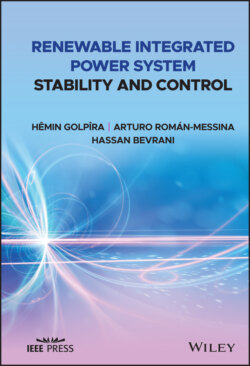Читать книгу Renewable Integrated Power System Stability and Control - Hassan Bevrani - Страница 21
1.3 Data‐Driven Wide‐Area Power System Monitoring and Control
ОглавлениеPower grids modeling and control has become a more challenging issue due to the increasing penetration of RESs, changing system structure and the integration of new storage systems, controllable loads and power electronics technologies, and reduction of system inertia. Conventional modeling and control designs may not be any more effective to satisfy all specified objectives in various operation modes of modern power grids. These challenging issues set new demand for the development of more flexible, rapid, effective, precise, and adaptive approaches for power system dynamic monitoring, stability/security analysis, and control problems. Thanks to recent advances in control, communication, and computing technologies, it is possible to tackle mentioned challenges by implementing a data‐driven‐based modeling and control framework as shown in Figure 1.2.
The system data are collected from the distributed PMUs in the grid through a secure communication network. The development of information and communication technology (ICT) enables more flexibility in wide‐area monitoring of power system with fast and large data transmission. Especially, the wide‐area measurement system (WAMS) with PMUs is a promising technique as one of the smart grid technologies in the bulk power grid.
Figure 1.2 An overall data‐driven control framework for renewable integrated power systems.
The measured data are locally saved and then collected by phasor data concentrators (PDCs) for the post analysis or sent to a remote location via a standard data format. These data with the time stamp of the synchronized GPS in real time may applied for parameter and state estimations and finally used for the system protection and/or real‐time control. Figure 1.3 shows how a PMU‐based WAMS can provide data for the power system control center to generate continuous (in normal states) and discontinuous control (in off‐normal states) commands.
Before any application, the collected PMU data need to be cleaned and de‐noised and employed by the data processors for estimation, modeling, and control purposes. The proposed de‐noising method may use a rolling‐averaging window with pre‐specified length to remove noise from the recorded data. The block of parameters estimation algorithms contains high fast and precise algorithms for estimation of some important parameters and transient characteristics that are required to use in control tuning algorithm or to detect a contingency and triggering the emergency control and protection schemes. In case of crossing the assigned thresholds showing an off‐normal and emergency condition, the recorded data and some estimated parameters are used to detect the amount of mismatch (size of disturbance) for the emergency control and protection schemes such as load shedding algorithms. Otherwise, the estimated parameters such as scheduling parameters are employed by the continuous control systems.
Figure 1.3 PMU‐based wide‐area measurement system and control.
As mentioned, using significant number of distributed micro‐sources into power systems adds new technical challenges. As the electric industry seeks to reliably integrate large amounts of DGs/RESs into the power system in regulated environment, considerable effort is needed to accommodate and effectively manage the installed micro‐sources. A key aspect is how to handle changes in topology and dynamics caused by penetration of numerous DGs/RESs in the network and how to make the power grid robust and able to take advantage of the potential flexibility of distributed micro‐sources. In a modern control framework, a part of power produced by available DGs/RESs in the grid are used as a primary energy source of inertia emulator to provide virtual inertia as a supporting control for abovementioned controllers (like a fine tuner) to improve power grid stability.
